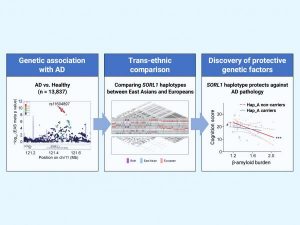
An international research team led by the Hong Kong University of Science and Technology (HKUST) has identified key genetic factors that confer protective effects against Alzheimer’s disease (AD) through a comprehensive genetic analysis of East Asian populations, including Chinese and Japanese, as well as European populations. This groundbreaking discovery sheds light on how these genetic factors can exert protective effects, unveiling the biological mechanisms underlying AD pathogenesis.
At a glance:
In the past decade, research into theSORL1gene (Sortilin-Related Receptor 1) has gained attention in the field of AD, as the protein it encodes, SORL1, plays a crucial role in regulating the production and clearance of amyloid-beta, a toxic protein that contributes to the pathology of AD. Studies conducted in individuals of European descent have suggested that certainSORL1genetic variants exert protective effects against AD, making it a potential target for disease intervention. However, most genetic studies have mainly focused on the European population, leaving gaps in understanding howSORL1variants affect other ethnic groups. Therefore, investigatingSORL1genetic variants in the East Asian population will provide new insights into how these variants may exert protection against AD. This highlights the importance of comprehensive research that includes diverse ethnic groups to enhance our understanding of how ancestral backgrounds influence the genetic mechanisms underlying the disease.
To investigate howSORL1genetic variants protect against AD in diverse populations, a multidisciplinary team led by Prof. Nancy IP, President and the Morningside Professor of Life Science at HKUST and Director of the Hong Kong Center for Neurodegenerative Diseases (HKCeND), performed a comprehensive genetic association analysis across East Asian populations, including individuals from mainland China, Hong Kong, and Japan, as well as European populations. This research was conducted in collaboration with Prof. John Hardy from University College London, Prof. Akinori Miyashita from Niigata University, and Prof. Yu Chen from the Shenzhen Institutes of Advanced Technology, Chinese Academy of Sciences, while also integrating data from international databases, including the Alzheimer’s Disease Neuroimaging Initiative.
The team identified keySORL1genetic variants in both East Asian and European populations. In particular, the Hap_A variant showed a strong protective effect against AD in the East Asian population, while it is relatively rare in the European population. The prevalence of Hap_A in East Asians is 168 times that of Europeans. Their analysis revealed that individuals carrying the Hap_A variant had better cognitive function, decreased neurodegeneration, and less severe AD pathology when compared with those not carrying the variant. Their findings demonstrated that different ethnic groups exhibit distinct sets of variants that exert AD-protective roles.
To further understand the biological mechanisms of these AD-protectiveSORL1genetic variants, the team comprehensively examined the functional roles of the variants. Their results showed that the AD-protective genetic variants are associated with increased SORL1 protein expression and may modulate biological pathways related to both immune and neuronal functions. Notably, the team identified a specific coding variant that regulates the expression and function of a SORL1 protein isoform, which had not been comprehensively studied previously. This finding provides new insights into the molecular mechanism underlying how SORL1 protein modulates AD risk.
“This study enhances our understanding of the role of SORL1 in AD and has uncovered its potential for therapeutic development,” said Prof. Ip. “Our research, built on international collaboration, contributes to one of the most comprehensive East Asian human databases for AD, serving as a valuable resource for studies of AD genetic factors in diverse ethnic populations.”
The research was supported by the National Natural Science Foundation of China (NSFC) and the Research Grants Council (RGC) of Hong Kong Joint Research Scheme and the InnoHK scheme of the HKSAR government. It was conducted in collaboration with researchers from University College London and Niigata University, as well as clinicians from the Prince of Wales Hospital and Queen Elizabeth Hospital. The findings have been recently published inAlzheimer’s & Dementia: The Journal of the Alzheimer’s Association, and featured onAlzforum, a scholarly exchange platform focused on AD research.

HKUST President Prof. Nancy IP (center) is joined by co-first author of this research paper and former Research Assistant Professor at HKUST Division of Life Science, Prof. ZHOU Xiaopu (left), and former Research Associate at HKCeND, ZHONG Huan (right).

The team has identified numerous SORL1 genetic variants that protect against the risk of Alzheimer’s disease (AD) in the East Asian and European populations. By comparing the genetic structure across different populations, the team has further dissected the most critical AD-protective SORL1 variants in both groups. The specific genetic variant Hap_A of SORL1 is associated with an alleviated cognitive decline in patients with AD, indicating its important protective mechanism.
Reposted from https://hkust.edu.hk/news.